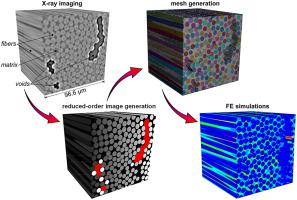Composites Science and Technology ( IF 8.3 ) Pub Date : 2021-08-19 , DOI: 10.1016/j.compscitech.2021.109004 Peter J. Creveling 1 , John Fisher 1 , Chris Dahlkamp 1 , Michael W. Czabaj 1

|
A new approach is presented to convert X-ray microcomputed tomography (μCT) image data of as-manufactured fiber-reinforced microstructures into high-fidelity finite element (FE) meshes. The mesh-generation approach leverages existing image segmentation and meshing tools to generate FE meshes of a woven-fabric and fiber-reinforced composite (FRCs), where constituents in each microstructure are represented explicitly. Segmentation of fibers from X-ray μCT images was performed using a template-matching/Kalman-filter estimation algorithm, and flaws were segmented using Trainable Weka Segmentation. Segmentation data were converted into reduced-order images, which were subsequently imported into Simpleware™ for mesh generation. To demonstrate advancements of the mesh-generation process, biaxial and uniaxial FE simulations were performed in Abaqus® for the woven- and FRC microstructures, respectively. Results reveal that the mesh-generation approach allows for modeling of distinct interactions between constituents, including contact/friction between fibers and interactions at the fiber-matrix interfaces. Results from this work demonstrate that X-ray μCT images of complex fiber-reinforced microstructures can be converted into high-fidelity meshes, but the high number of elements required for discretization necessitates additional work to improving mesh efficiency.
中文翻译:

基于 X 射线显微计算机断层扫描对制造的纤维增强微结构进行建模
提出了一种将制造的纤维增强微结构的 X 射线显微计算机断层扫描 (μCT) 图像数据转换为高保真有限元 (FE) 网格的新方法。网格生成方法利用现有的图像分割和网格划分工具来生成机织织物和纤维增强复合材料 (FRC) 的 FE 网格,其中明确表示每个微结构中的成分。使用模板匹配/卡尔曼滤波器估计算法对来自 X 射线 μCT 图像的纤维进行分割,并使用可训练的 Weka 分割对缺陷进行分割。分割数据被转换为降阶图像,随后将其导入 Simpleware™ 以生成网格。为了展示网格生成过程的进步,在 Abaqus® 中分别对编织和 FRC 微结构进行了双轴和单轴有限元模拟。结果表明,网格生成方法允许对成分之间的不同相互作用进行建模,包括纤维之间的接触/摩擦以及纤维-基质界面处的相互作用。这项工作的结果表明,复杂纤维增强微结构的 X 射线 μCT 图像可以转换为高保真网格,但离散化所需的大量元素需要额外的工作来提高网格效率。











































 京公网安备 11010802027423号
京公网安备 11010802027423号